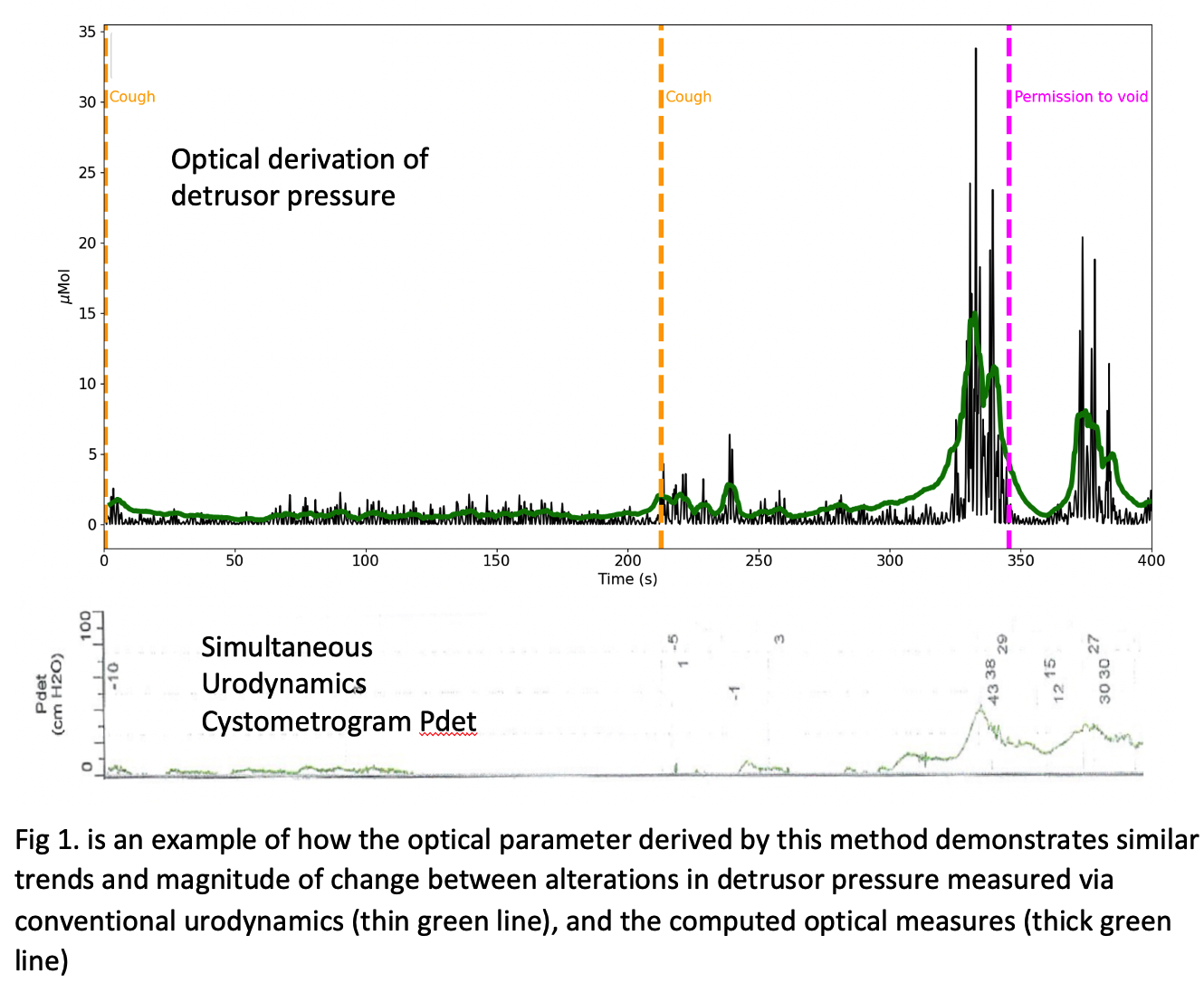Back
Introduction: Gold standard urodynamic studies use invasive methods and artificial filling of the bladder to determine detrusor pressure, a critical physiologic measure in determining care for lower urinary tract symptoms (LUTS). The benefits of non-invasive measurement of detrusor pressure (Pdet) include natural filling observations & the potential for a homebased wearable with real time data to determine both self-care and monitoring.
Aim: to develop a wearable optical based technology to relate non-invasively measured changes in Pdet during natural filling.
Methods: A 10 x 10 cm optical grid using light emitting diodes (LED’s) (750 nm – 950 nm) was engineered & positioned suprapubically during simultaneous multichannel urodynamics (UDS). LED’s were paired with photodetectors, sampling at 50Hz from long (deep) and short (superficial) channels facilitating optical output compared to variations in Pdet. Output: Arterial pulse waveform changes in chromophore concentration related to variations in detrusor oxygenation (O2Hb), & fluctuations in the absorption of photons at 950nm (H20) related to CMG volume increases. Peak & trough envelopes were computed with Hilbert transformation and a filtered moving average was used mathematically.
Results: N= 25 (5 controls no LUTS & 20 NLUTD female = N=5 age 64-82 yrs ASIA A, B & D; male = N= 15 age 33 – 79 yrs being ASIA A,B,C &D. NLUTD management included: N= 4 subjects using clean intermittent catheterization (CIC), 2 condom drainage, 5 using combinations of CIC and spontaneous voiding, 4 spontaneous voiding only. No subjects used anticholinergics, B 3 agonists or prior intra detrusor botulinum toxin. Controls: natural filling and uroflow, no LUTS on IPSS or UGDI, no prior GU surgery, volumes >150cc, repeated filling & emptying for internal consistency measures.
Conclusions: A prototype wearable able to derive a real-time, non-invasive measure reflecting detrusor pressure was successfully prototyped. If further research confirms the ability of an optical parameter derived in this way to mirror variations in detrusor pressure, benefits that would accrue include: more frequent assessment than is possible with invasive UDS, & the ability to monitor changes in pressure continuously in an at risk population (e.g. NLUTD at risk for autonomic dysreflexia). SOURCE OF
Funding: Craig H Neilsen Foundation

Podium Session
Session: PD33: Urodynamics/Lower Urinary Tract Dysfunction/Female Pelvic Medicine: Non-neurogenic Voiding Dysfunction II
PD33-10: Non-invasive Optical Determination of Detrusor Pressure Related to Detrusor Overactivity
Sunday, April 30, 2023
2:30 PM – 2:40 PM CST
Location: S501C
- LS
Lynn Stothers, MD
University of British Columbia
Podium Presenter(s)
Introduction: Gold standard urodynamic studies use invasive methods and artificial filling of the bladder to determine detrusor pressure, a critical physiologic measure in determining care for lower urinary tract symptoms (LUTS). The benefits of non-invasive measurement of detrusor pressure (Pdet) include natural filling observations & the potential for a homebased wearable with real time data to determine both self-care and monitoring.
Aim: to develop a wearable optical based technology to relate non-invasively measured changes in Pdet during natural filling.
Methods: A 10 x 10 cm optical grid using light emitting diodes (LED’s) (750 nm – 950 nm) was engineered & positioned suprapubically during simultaneous multichannel urodynamics (UDS). LED’s were paired with photodetectors, sampling at 50Hz from long (deep) and short (superficial) channels facilitating optical output compared to variations in Pdet. Output: Arterial pulse waveform changes in chromophore concentration related to variations in detrusor oxygenation (O2Hb), & fluctuations in the absorption of photons at 950nm (H20) related to CMG volume increases. Peak & trough envelopes were computed with Hilbert transformation and a filtered moving average was used mathematically.
Results: N= 25 (5 controls no LUTS & 20 NLUTD female = N=5 age 64-82 yrs ASIA A, B & D; male = N= 15 age 33 – 79 yrs being ASIA A,B,C &D. NLUTD management included: N= 4 subjects using clean intermittent catheterization (CIC), 2 condom drainage, 5 using combinations of CIC and spontaneous voiding, 4 spontaneous voiding only. No subjects used anticholinergics, B 3 agonists or prior intra detrusor botulinum toxin. Controls: natural filling and uroflow, no LUTS on IPSS or UGDI, no prior GU surgery, volumes >150cc, repeated filling & emptying for internal consistency measures.
Conclusions: A prototype wearable able to derive a real-time, non-invasive measure reflecting detrusor pressure was successfully prototyped. If further research confirms the ability of an optical parameter derived in this way to mirror variations in detrusor pressure, benefits that would accrue include: more frequent assessment than is possible with invasive UDS, & the ability to monitor changes in pressure continuously in an at risk population (e.g. NLUTD at risk for autonomic dysreflexia). SOURCE OF
Funding: Craig H Neilsen Foundation

